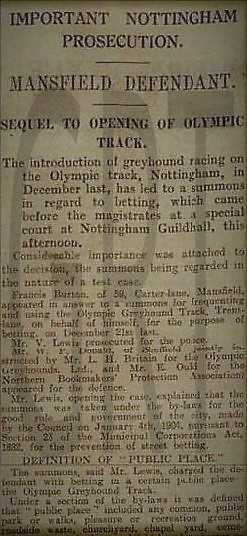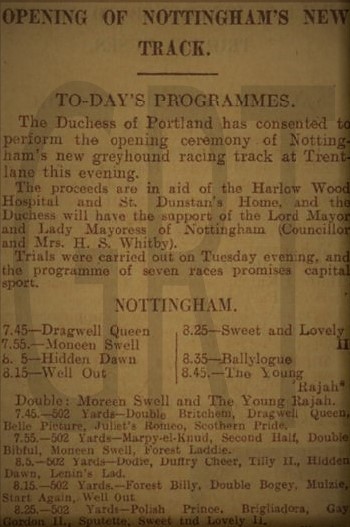White City Stadium, Trent Lane, Colwick, Nottingham.
POSTCODE———————————-NG2 4DS
LOCATED————————————About 300 yards west the the present day Colwick Park Greyhound Stadium.
ORIGINAL SITE—————————–Grazing land adjacent to a Pumpin Station.
DATE CONSTRUCTED——————–1929
DATE VENUE OPENED——————-March 1929 for Grass track speedway.
Meaning other sports may have taken place prior to the arrival of Greyhound Racing.
FIRST MEETING—————————–December 21st 1931 when called The Olympic Stadium. Closed for improvements on 17th September 1932 and re-opened as Nottingham White City on June 24th, 1933.
Greyhound Racing only.
LICENSED OR INDEPENDENT———-Originally independent but switched NGRC in June 1933.
All venues covered would have to be licensed with the government, licensed suggested in this section would refer to tracks operating under NGRC Rules.
INSIDE OR OUTSIDE HARE TYPE——Outside
Please note that the Electric Hare suggested is only a guidance and would have been in operation for a certain amount of time at this venue. Although it is not necessarily guaranteed that it was operational all the time, as other types of lure may have been used and updated as time progressed.
DISTANCES———————————–360 and 525 yards.
Please note that most racing venues distances had become varied throughout the years, the ones given above were at once point set and offers only a guidance to the track size.
CIRCUMFERENCE—————————Don’t know.
Please note that alterations at most racing venues throughout its existence would see that the circumference of the track would vary, the one shown above offers only a guidance to the track size.
BIG RACE NAMES—————————Nothing known of.
STADIUM SHARED WITH——————Speedway up until 1938.
LAST MEETING——————————-September 12th 1970.
Greyhound Racing only.
STADIUM CLOSURE DATE—————-September 1970.
Meaning other sports may have taken place after Greyhound Racing had ceased.
STADIUM DEMOLITION——————-1970-71
BUILT ON SITE——————————-Companys to the north of Little Tennis Street and The Gunn and More company situated on Trent Lane now pinpoints its once location.
In some cases, structure’s that originally covered the venue after the stadium had been demolished, may have been themselves demolished too, so the one described is more likely to be the one which now presently covers the site.
EVIDENCE LEFT TODAY——————-A breeze block wall to the south of The Gun and Moore factory is still there, and is shown clearly at the rear of the derelict results board photo.
FURTHER COMMENTS——————–The venue’s original name was The Olympic Stadium.












Greyhound Racing in Nottingham is presently staged at The Colwick Park Stadium, a venue located very close to the Nottingham Racecourse on the eastern side of the city. But Greyhound Racing had featured during the early 1930’s at another venue close by, situated just off Trent Lane, two and a half miles east of the city centre. It was known as The Olympic Stadium, having been constructed on a section of land close to the River Trent, that happened to be owned by The Water Board. Earlier, the land had been used as a temporary Grass Track Speedway venue during 1927, but it wasn’t until early 1929 that the venue became enclosed. It had developed under the guidance of a company calling themselves The Olympic Speedways Limited, who began staging events during March 1929, but due to the sport running at a loss the venture was scrapped after two seasons.
The speedway team eventually folded during 1931 due to them being unable to raise a team. It was at this point that another Speedway promoter took control of running the stadium, but this individual happened to be a keen Greyhound Racing enthusiast also. His new ideas would see the Speedway track reduced in size, enough to compensate for the new greyhound track to be laid around the speedway’s perimeter fence.
Opening up as a flapping track, The Olympic Stadium was now ready to stage Greyhound Racing for the first time on the 19th of December 1931. But the opening event went sadly wrong as freezing fog ascended on Nottingham that evening, and forced the cancellation of the meeting, but the rearranged fixture went ahead two days later on the following Monday night. The arrival of the two sports had been a success, and the numbers of patrons flocking through the turnstiles were proving too much, as it was soon realised that the venue was too small and inappropriate to cope with regular large crowds. A decision was made to reconstruct the venue, which meant all sporting activities would have to come to a temporary halt, until the venue had been totally rebuilt.
It was during September 1932 that the old Olympic Stadium ran its final greyhound meeting, only to see it demolished soon after to make way for the new venue. Once complete it became known as The White City Stadium Nottingham, with the new project consisting of a huge two-tiered grandstand, with enough seats to accommodate 500 onlookers, along with two terraced covered stands that flanked either side of it, which overlooked both bends. To improve drainage, the old Speedway track was raised by three feet, along with a new grass running surface being laid for the greyhounds.
Although Speedway Racing had christened the stadium on the 11th of May 1933, it was on the 24th of June that The New White City hosted Greyhound Racing for the first time. All events would now be staged under NGRC rules, with all the greyhounds being track owned, all of which were kennelled behind the main stand. Races consisted of five greyhounds contesting over a distance of 502 Yards, with the hounds chasing an inside Sumner type hare. Further improvements had seen racing distances increased to 360 and 525 yards.
Although greyhound racing had become a success, a decreased interest for Speedway Racing seen it feature for the last time during 1938. With no further plans for speedway, the cinder track became concreted over, and acted as a parade ring for the greyhounds. The declaration of the Second World War had witnessed a three week ban on Greyhound Racing throughout the country, other than that racing at the Notts venue would continue to promote meetings throughout the whole conflict, albeit during daylight hours. But it was during the late 1960’s that the Nottingham White City sensed that its days were numbered with an article printed in The Greyhound Owner of December 1969, regarding a decision had been made to close the track.
The reason was that although the venue was operating at a small profit, the stadium was in need of some serious repairs, and it came as no surprise when the stadium became sold to developers. An offer was made by The Greyhound Council to buy the stadium for £125,000, with the view of continuing racing, but the offer was rejected as the present stadium’s owners had confirmed that the sale of the six-acre site had already been done.
Sadly, all operations ceased on the 12th of September 1970, seeing the stadium bulldozed almost immediately, only to be replaced in time by warehousing and an Industrial Estate. Trent Lane lies just off the A612 and is situated within 300 yards of the existing Colwick Park Greyhound Stadium. A company known Gunn and Moore situated on Trent Lane, pinpoints the stadiums once location, with a breeze block wall on its southern edge visible on a photo at the rear of the results board.
A programme, photograph or even memorabilia for this track is required for this page, if you can help please contact me.

Recent Comments